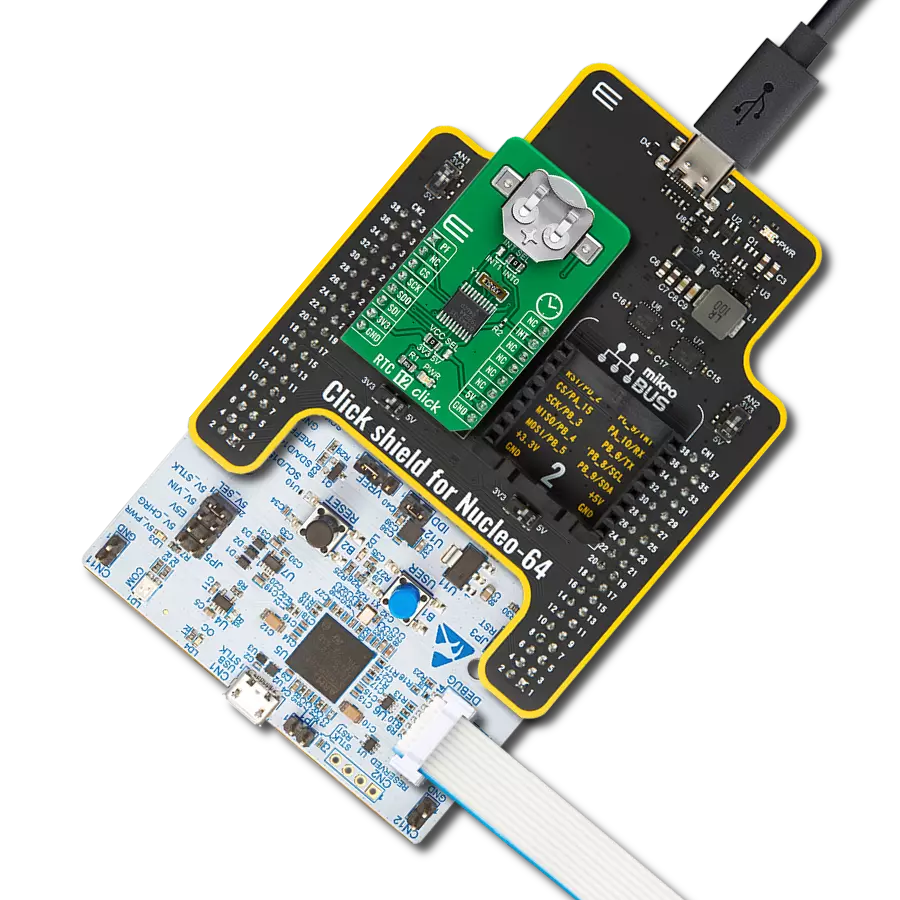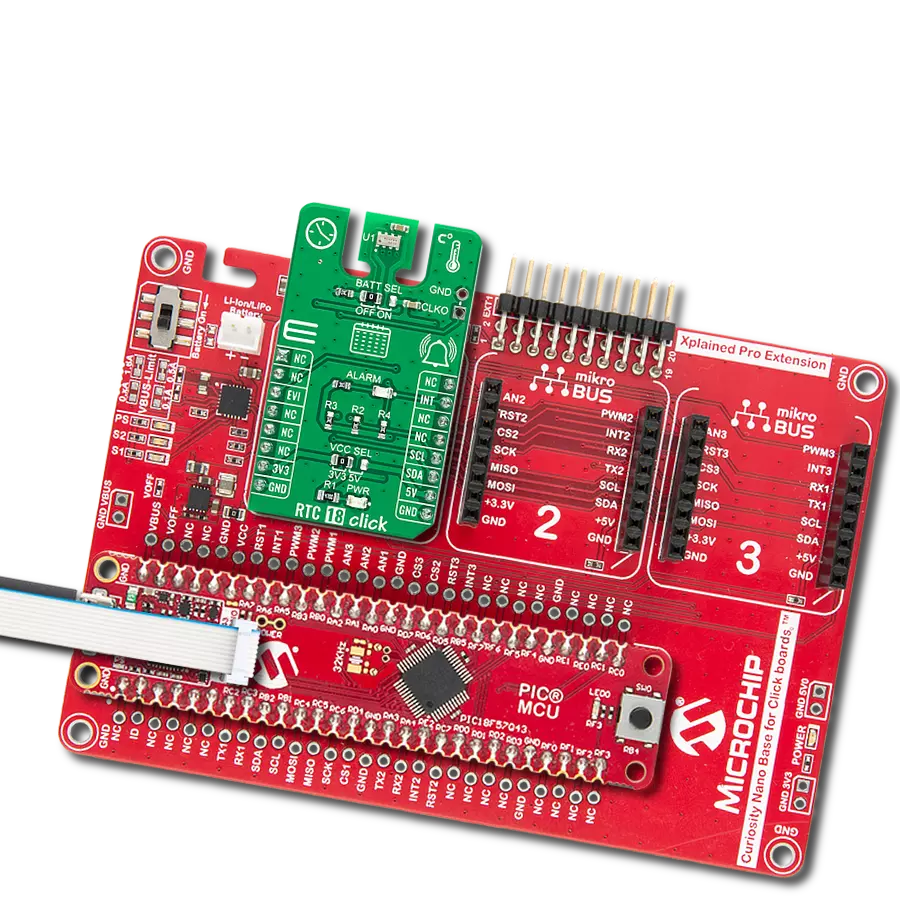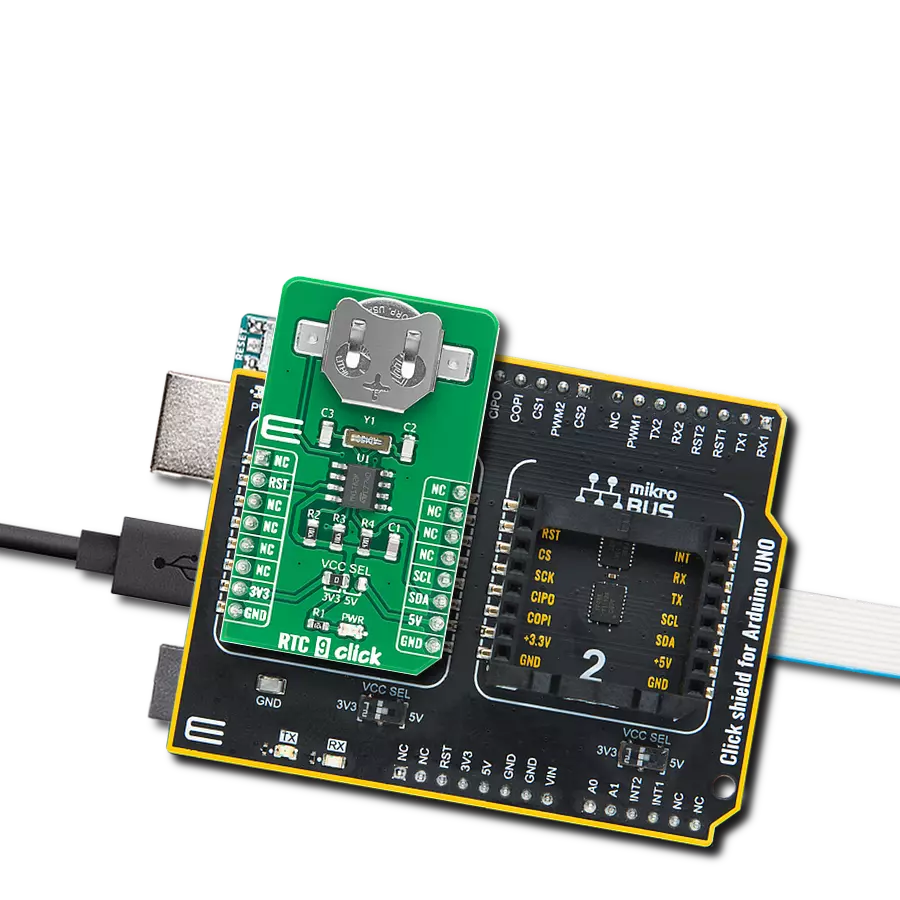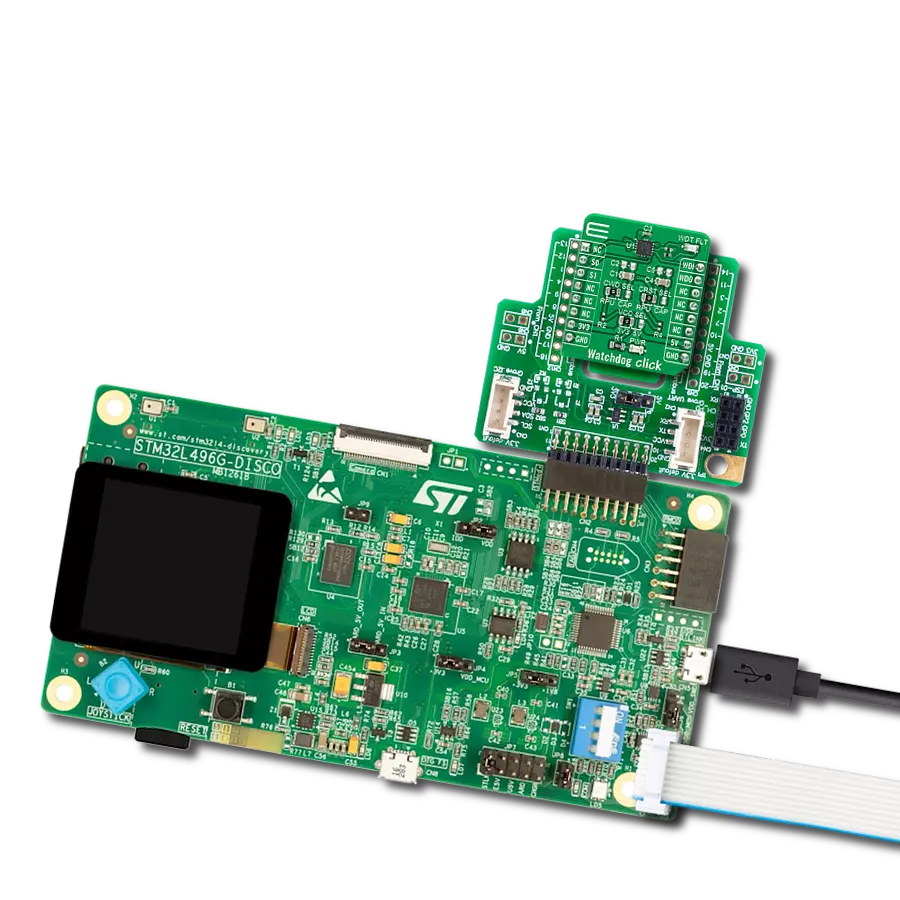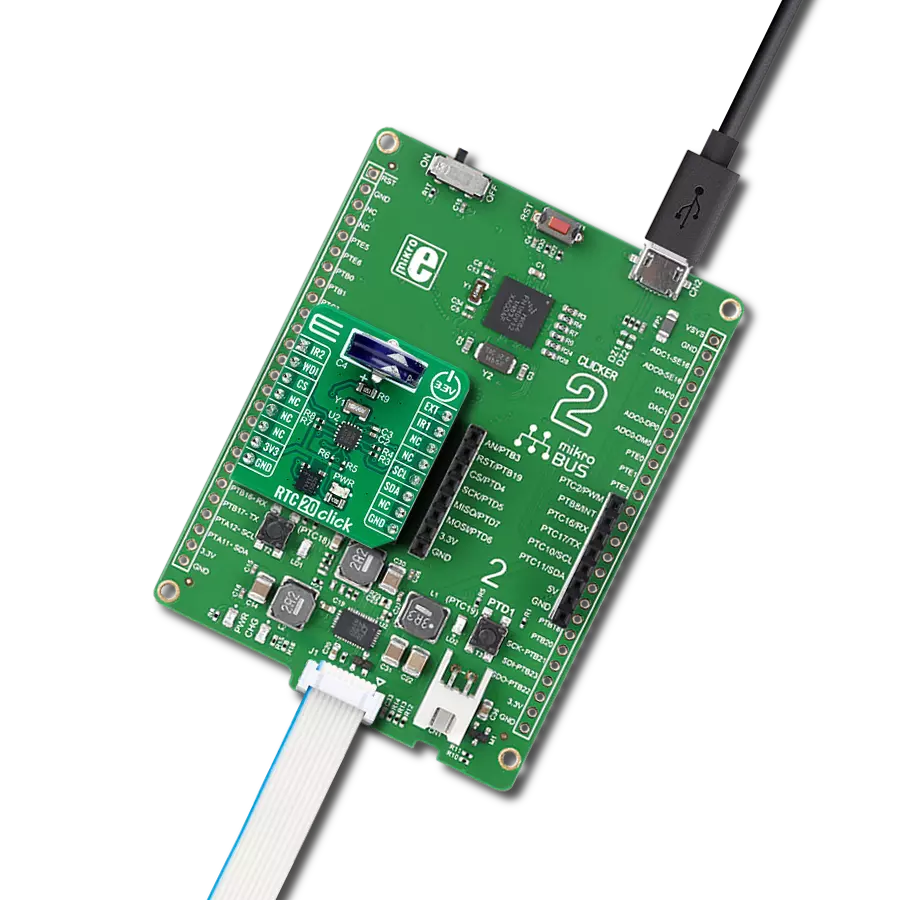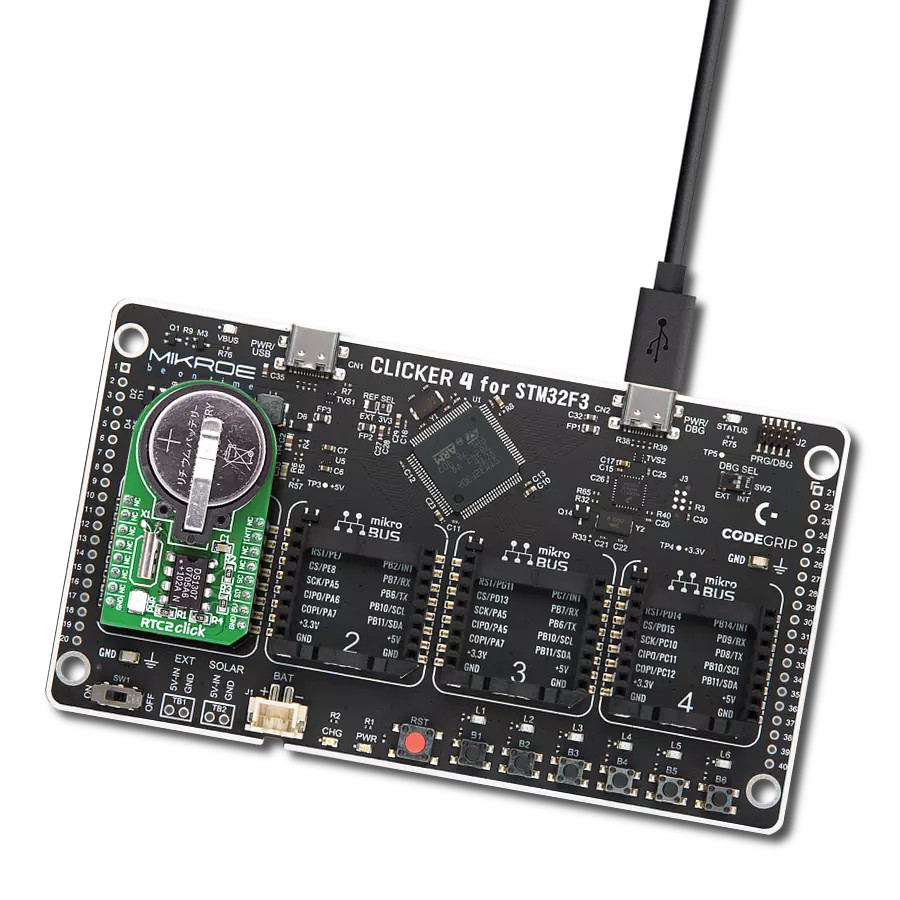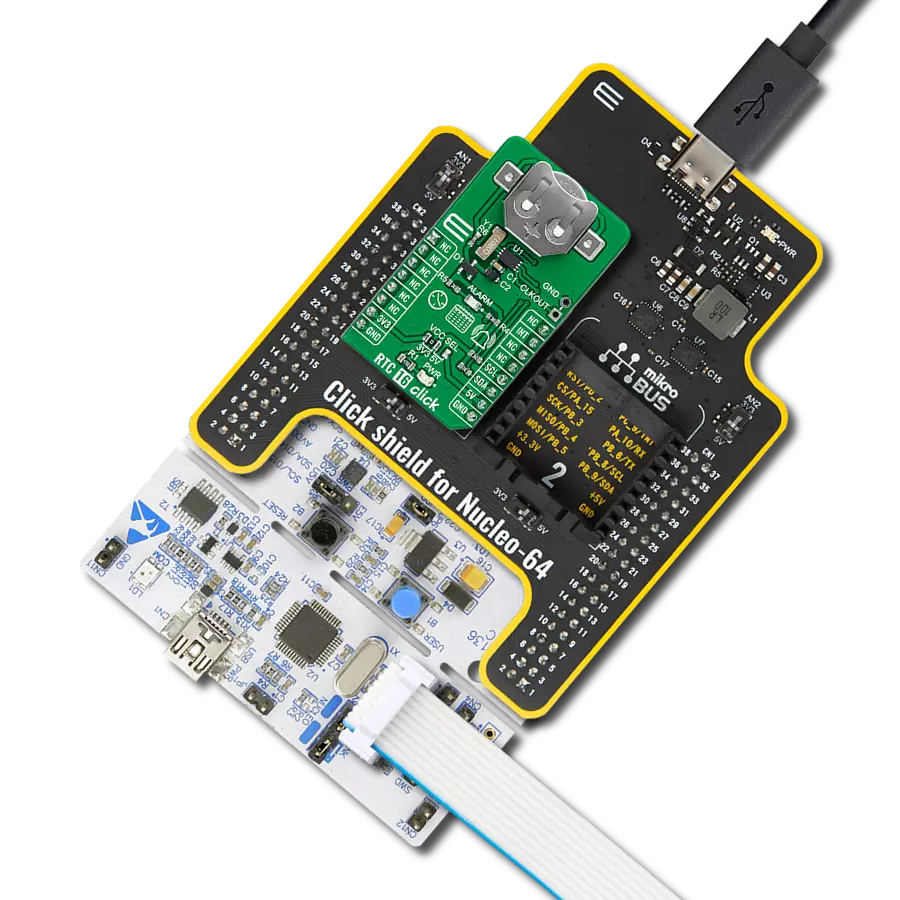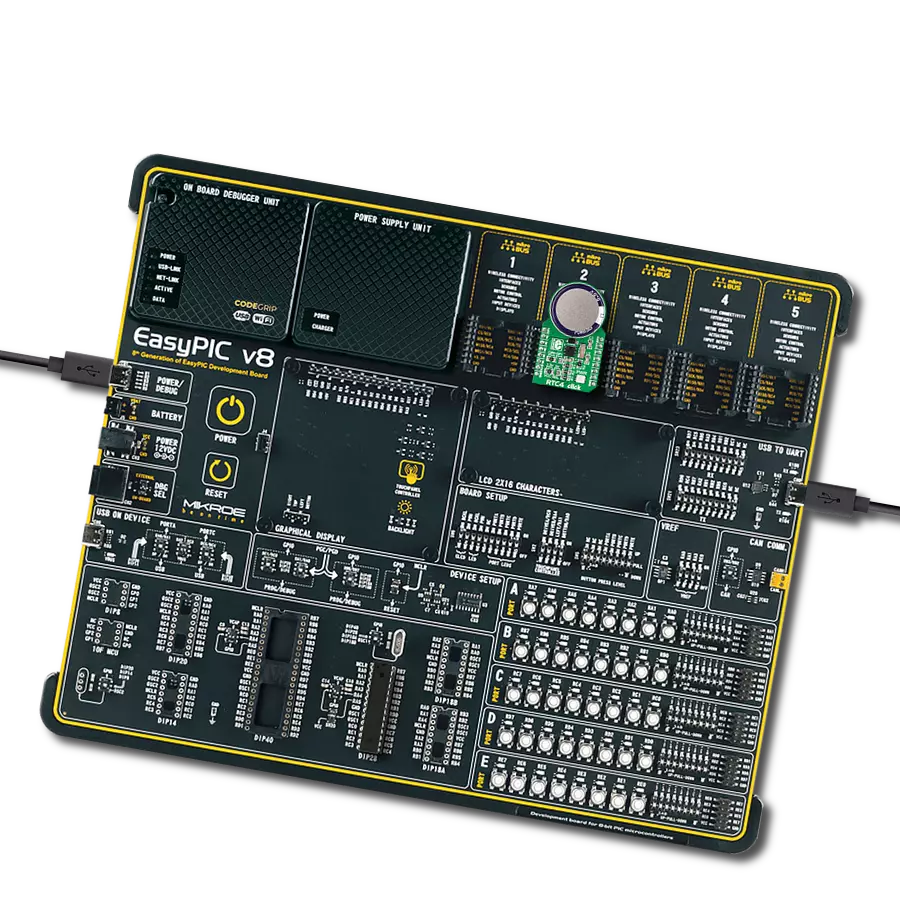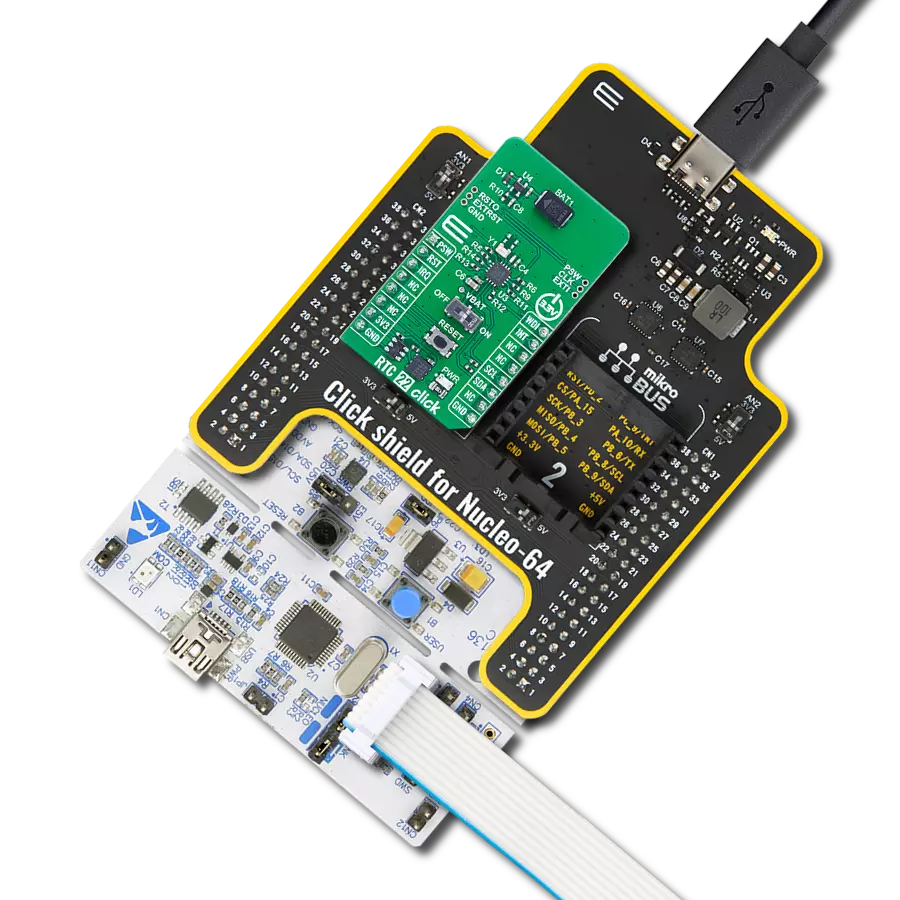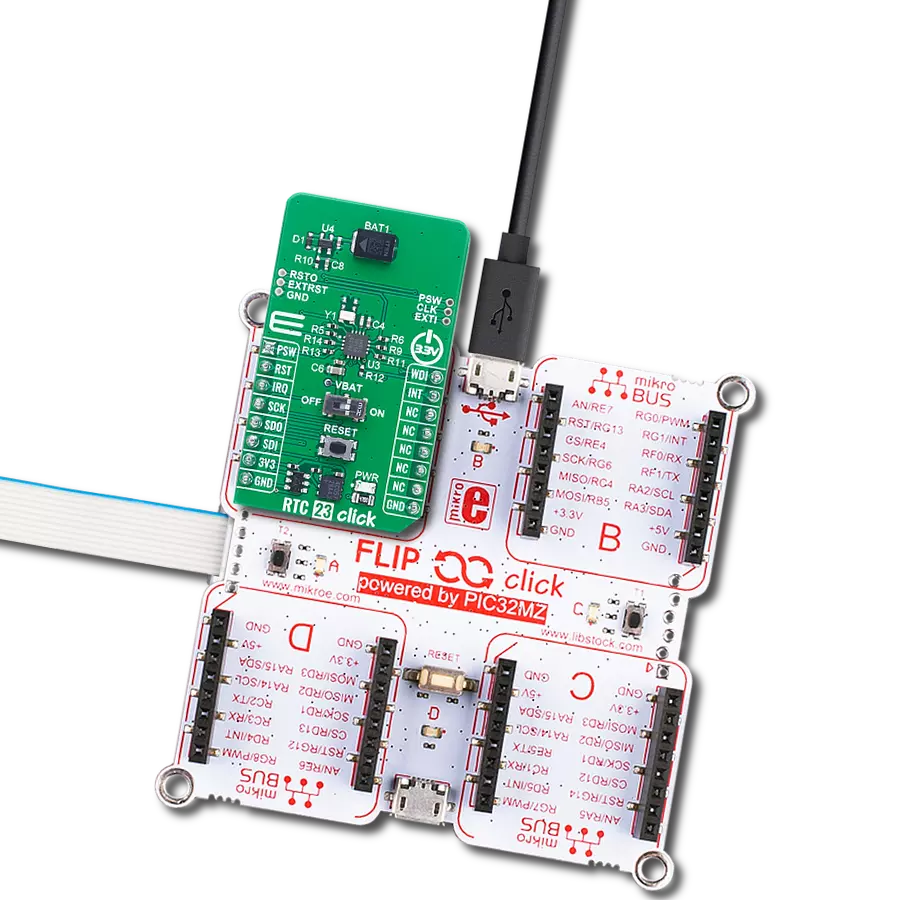Elevate your engineering solutions with our advanced real-time clock, ensuring accurate time tracking and synchronization
A
A
Hardware Overview
How does it work?
RTC 13 Click is based on the PCF2123, an SPI configurable real-time clock/calendar optimized for low-power operations from NXP Semiconductors. It contains sixteen 8-bit registers with an auto-incrementing address counter, an on-chip 32.768kHz oscillator with two integrated load capacitors, a frequency divider that provides the source clock for the RTC, and a programmable clock output. The integrated oscillator ensures year, month, day, weekday, hours, minutes, and seconds, making this Click board™ suitable for various time-keeping applications such as high-duration timers, daily alarms, and more. The PCF2123 communicates with MCU using the standard SPI serial interface with a maximum
frequency of 8MHz, where data transfers serially with a maximum data rate of 6.25 Mbit/s. An alarm and timer function is also available, providing the possibility to generate a wake-up signal on an interrupt line, available on the INT pin of the mikroBUS™ socket and indicated by a red LED marked as INT. Besides, this Click board™ also has an onboard header labeled CLKOUT, which provides a programmable square-wave output clock signal controlled by one GPIO pin, a CLE pin routed to the RTS pin, the mikroBUS™ socket. Frequencies of 32.768kHz, representing a default value of 1Hz, can be generated and used as a system and MCU clock, input to a charge pump, or oscillator calibration. Like this one, the most
common RTC configuration is a battery-backed-up, which maintains time and continues its work without interruption during a power failure. That’s why, besides the PCF2123, the RTC 13 Click has a button cell battery holder compatible with the 3000TR battery holder, suitable for 12mm Coin Cell batteries. This Click board™ can operate with either 3.3V or 5V logic voltage levels selected via the VCC SEL jumper. This way, both 3.3V and 5V capable MCUs can use the communication lines properly. Also, this Click board™ comes equipped with a library containing easy-to-use functions and an example code that can be used as a reference for further development.
Features overview
Development board
Nucleo-64 with STM32F091RC MCU offers a cost-effective and adaptable platform for developers to explore new ideas and prototype their designs. This board harnesses the versatility of the STM32 microcontroller, enabling users to select the optimal balance of performance and power consumption for their projects. It accommodates the STM32 microcontroller in the LQFP64 package and includes essential components such as a user LED, which doubles as an ARDUINO® signal, alongside user and reset push-buttons, and a 32.768kHz crystal oscillator for precise timing operations. Designed with expansion and flexibility in mind, the Nucleo-64 board features an ARDUINO® Uno V3 expansion connector and ST morpho extension pin
headers, granting complete access to the STM32's I/Os for comprehensive project integration. Power supply options are adaptable, supporting ST-LINK USB VBUS or external power sources, ensuring adaptability in various development environments. The board also has an on-board ST-LINK debugger/programmer with USB re-enumeration capability, simplifying the programming and debugging process. Moreover, the board is designed to simplify advanced development with its external SMPS for efficient Vcore logic supply, support for USB Device full speed or USB SNK/UFP full speed, and built-in cryptographic features, enhancing both the power efficiency and security of projects. Additional connectivity is
provided through dedicated connectors for external SMPS experimentation, a USB connector for the ST-LINK, and a MIPI® debug connector, expanding the possibilities for hardware interfacing and experimentation. Developers will find extensive support through comprehensive free software libraries and examples, courtesy of the STM32Cube MCU Package. This, combined with compatibility with a wide array of Integrated Development Environments (IDEs), including IAR Embedded Workbench®, MDK-ARM, and STM32CubeIDE, ensures a smooth and efficient development experience, allowing users to fully leverage the capabilities of the Nucleo-64 board in their projects.
Microcontroller Overview
MCU Card / MCU
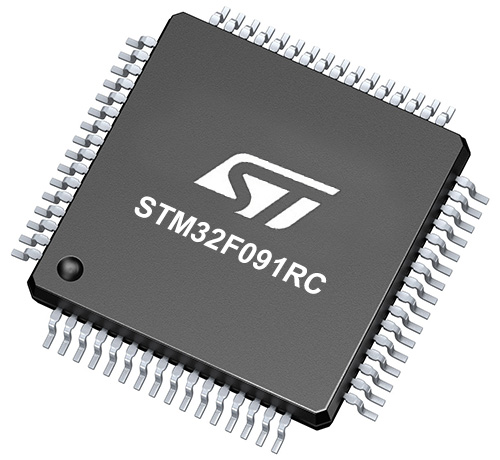
Architecture
ARM Cortex-M0
MCU Memory (KB)
256
Silicon Vendor
STMicroelectronics
Pin count
64
RAM (Bytes)
32768
You complete me!
Accessories
Click Shield for Nucleo-64 comes equipped with two proprietary mikroBUS™ sockets, allowing all the Click board™ devices to be interfaced with the STM32 Nucleo-64 board with no effort. This way, Mikroe allows its users to add any functionality from our ever-growing range of Click boards™, such as WiFi, GSM, GPS, Bluetooth, ZigBee, environmental sensors, LEDs, speech recognition, motor control, movement sensors, and many more. More than 1537 Click boards™, which can be stacked and integrated, are at your disposal. The STM32 Nucleo-64 boards are based on the microcontrollers in 64-pin packages, a 32-bit MCU with an ARM Cortex M4 processor operating at 84MHz, 512Kb Flash, and 96KB SRAM, divided into two regions where the top section represents the ST-Link/V2 debugger and programmer while the bottom section of the board is an actual development board. These boards are controlled and powered conveniently through a USB connection to program and efficiently debug the Nucleo-64 board out of the box, with an additional USB cable connected to the USB mini port on the board. Most of the STM32 microcontroller pins are brought to the IO pins on the left and right edge of the board, which are then connected to two existing mikroBUS™ sockets. This Click Shield also has several switches that perform functions such as selecting the logic levels of analog signals on mikroBUS™ sockets and selecting logic voltage levels of the mikroBUS™ sockets themselves. Besides, the user is offered the possibility of using any Click board™ with the help of existing bidirectional level-shifting voltage translators, regardless of whether the Click board™ operates at a 3.3V or 5V logic voltage level. Once you connect the STM32 Nucleo-64 board with our Click Shield for Nucleo-64, you can access hundreds of Click boards™, working with 3.3V or 5V logic voltage levels.
Used MCU Pins
mikroBUS™ mapper
Take a closer look
Click board™ Schematic

Step by step
Project assembly
Software Support
Library Description
This library contains API for RTC 13 Click driver.
Key functions:
rtc13_get_time- RTC 13 get time functionrtc13_set_time- RTC 13 set time functionrtc13_get_date- RTC 13 get date function
Open Source
Code example
The complete application code and a ready-to-use project are available through the NECTO Studio Package Manager for direct installation in the NECTO Studio. The application code can also be found on the MIKROE GitHub account.
/*!
* @file main.c
* @brief RTC13 Click example
*
* # Description
* This is an example that demonstrates the use of the RTC 13 Click board™.
*
* The demo application is composed of two sections :
*
* ## Application Init
* Initialization of SPI module, log UART and additional pins.
* After driver initialization and default settings,
* the app set the time to 23:59:50 and set the date to 04.08.2021.
*
* ## Application Task
* This is an example that shows the use of a RTC 13 Click board™.
* In this example, we read and display the current time and date,
* which we also previously set.
* Results are being sent to the Usart Terminal where you can track their changes.
* All data logs write on USB changes every 1 sec.
*
* @author Nenad Filipovic
*
*/
#include "board.h"
#include "log.h"
#include "rtc13.h"
static rtc13_t rtc13;
static log_t logger;
static uint8_t new_sec = 255;
static rtc13_time_t time;
static rtc13_date_t date;
void application_init ( void )
{
log_cfg_t log_cfg; /**< Logger config object. */
rtc13_cfg_t rtc13_cfg; /**< Click config object. */
/**
* Logger initialization.
* Default baud rate: 115200
* Default log level: LOG_LEVEL_DEBUG
* @note If USB_UART_RX and USB_UART_TX
* are defined as HAL_PIN_NC, you will
* need to define them manually for log to work.
* See @b LOG_MAP_USB_UART macro definition for detailed explanation.
*/
LOG_MAP_USB_UART( log_cfg );
log_init( &logger, &log_cfg );
log_info( &logger, " Application Init " );
// Click initialization.
rtc13_cfg_setup( &rtc13_cfg );
RTC13_MAP_MIKROBUS( rtc13_cfg, MIKROBUS_1 );
err_t init_flag = rtc13_init( &rtc13, &rtc13_cfg );
if ( SPI_MASTER_ERROR == init_flag )
{
log_error( &logger, " Application Init Error. " );
log_info( &logger, " Please, run program again... " );
for ( ; ; );
}
rtc13_default_cfg ( &rtc13 );
log_info( &logger, " Application Task " );
Delay_ms ( 100 );
date.weekday = 3;
date.day = 4;
date.month = 8;
date.year = 21;
rtc13_set_date( &rtc13, date );
Delay_ms ( 100 );
time.hours = 23;
time.min = 59;
time.sec = 50;
rtc13_set_time( &rtc13, time );
Delay_ms ( 100 );
}
void application_task ( void )
{
rtc13_get_time( &rtc13, &time );
Delay_ms ( 1 );
rtc13_get_date( &rtc13, &date );
Delay_ms ( 1 );
if ( time.sec != new_sec )
{
log_printf( &logger, " Date : %.2d-%.2d-%.2d\r\n", ( uint16_t ) date.day, ( uint16_t ) date.month, ( uint16_t ) date.year );
log_printf( &logger, " Time : %.2d:%.2d:%.2d\r\n", ( uint16_t ) time.hours, ( uint16_t ) time.min, ( uint16_t ) time.sec );
log_printf( &logger, "- - - - - - - - - - - -\r\n" );
new_sec = time.sec;
Delay_ms ( 1 );
}
}
int main ( void )
{
/* Do not remove this line or clock might not be set correctly. */
#ifdef PREINIT_SUPPORTED
preinit();
#endif
application_init( );
for ( ; ; )
{
application_task( );
}
return 0;
}
// ------------------------------------------------------------------------ END
Additional Support
Resources
Category:RTC



















